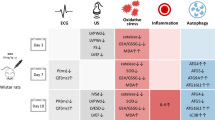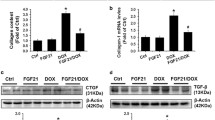Abstract
Doxorubicin (DOX) is a widely prescribed anthracycline antineoplastic drug for treating human solid tumors and leukemias. However, DOX therapy is limited by a cumulative, dose-dependent, and irreversible cardiomyopathy that occurs with repeated administration. Presumably, a pivotal initiating event of DOX-induced cardiotoxicity is the production of reactive oxygen species (ROS) and oxidation of lipids, DNA, and proteins. We recently identified activation of the Keap1/Nrf2-antioxidant response system—a major cellular defense mechanism against such oxidative stress—as an important response to acute DOX exposure in vitro. In the present study, we address the hypothesis that dysregulation of this pathway in cardiac tissue is also manifested in vivo following chronic DOX administration. Male, Sprague–Dawley rats received 6 weekly injections of 2 mg/kg (s.c.) DOX or saline followed by a 5-week drug-free period prior to analysis of cardiac tissue transcripts and proteins. In contrast to in vitro findings, the Keap1/Nrf2-antioxidant response system was suppressed in hearts of DOX-treated animals and consistent with the observed decrease in protein abundance for Nrf2 and PGAM5, both of which are substrates for Keap1. Although this shift in Keap1/Nrf2 suppresses the antioxidant pathway, the concurrent loss of PGAM5 could function as a signal for disposal of damaged mitochondria from the cell, thus removing the source of ROS. These findings identify the Keap1/Nrf2 and Keap1/PGAM5 pathways as important responses to DOX-induced cardiac injury in vivo; disruption of this system for mitochondrial hormesis may be an important contributing factor to cardiotoxicity after chronic drug administration.









Similar content being viewed by others
References
Lipshultz, S. E., Colan, S. D., Gelber, R. D., Perez-Atayde, A. R., Sallan, S. E., & Sanders, S. P. (1991). Late cardiac effects of doxorubicin therapy for acute lymphoblastic leukemia in childhood. New England Journal of Medicine, 324(12), 808–815. https://doi.org/10.1056/NEJM199103213241205.
Mettler, F. P., Young, D. M., & Ward, J. M. (1977). Adriamycin-induced cardiotoxicity (cardiomyopathy and congestive heart failure) in rats. Cancer Research, 37(8 Pt 1), 2705–2713. Retrieved from https://www.ncbi.nlm.nih.gov/entrez/query.fcgi?cmd=Retrieve&db=PubMed&dopt=Citation&list_uids=872096.
Sorensen, K., Levitt, G., Bull, C., Chessells, J., & Sullivan, I. (1997). Anthracycline dose in childhood acute lymphoblastic leukemia: issues of early survival versus late cardiotoxicity. Journal of Clinical Oncology, 15(1), 61–68. Retrieved from https://www.ncbi.nlm.nih.gov/entrez/query.fcgi?cmd=Retrieve&db=PubMed&dopt=Citation&list_uids=8996125.
Von Hoff, D. D., Layard, M. W., Basa, P., Davis Jr., H. L., Von Hoff, A. L., Rozencweig, M., & Muggia, F. M. (1979). Risk factors for doxorubicin-induced congestive heart failure. Annals of Internal Medicine, 91(5), 710–717. Retrieved from https://www.ncbi.nlm.nih.gov/entrez/query.fcgi?cmd=Retrieve&db=PubMed&dopt=Citation&list_uids=496103.
Bansal, N., Amdani, S. M., Hutchins, K. K., & Lipshultz, S. E. (2018). Cardiovascular disease in survivors of childhood cancer. Current Opinion in Pediatrics, 30(5), 628–638. https://doi.org/10.1097/MOP.0000000000000675.
Freireich, E. J., Gehan, E. A., Rall, D. P., Schmidt, L. H., & Skipper, H. E. (1966). Quantitative comparison of toxicity of anticancer agents in mouse, rat, hamster, dog, monkey, and man. Cancer Chemotherapy Reports, 50(4), 219–244. Retrieved from https://www.ncbi.nlm.nih.gov/pubmed/4957125.
Harake, D., Franco, V. I., Henkel, J. M., Miller, T. L., & Lipshultz, S. E. (2012). Cardiotoxicity in childhood cancer survivors: Strategies for prevention and management. Future Cardiology, 8(4), 647–670. https://doi.org/10.2217/fca.12.44.
Berthiaume, J. M., & Wallace, K. B. (2007). Adriamycin-induced oxidative mitochondrial cardiotoxicity. Cell Biology and Toxicology, 23(1), 15–25. https://doi.org/10.1007/s10565-006-0140-y.
Deavall, D. G., Martin, E. A., Horner, J. M., & Roberts, R. (2012). Drug-induced oxidative stress and toxicity. Journal of Toxicology, 2012, 645460. https://doi.org/10.1155/2012/645460.
Palmeira, C. M., Serrano, J., Kuehl, D. W., & Wallace, K. B. (1997). Preferential oxidation of cardiac mitochondrial DNA following acute intoxication with doxorubicin. Biochimica Biophysica Acta, 1321(2), 101–106. Retrieved from https://www.ncbi.nlm.nih.gov/pubmed/9332499.
Serrano, J., Palmeira, C. M., Kuehl, D. W., & Wallace, K. B. (1999). Cardioselective and cumulative oxidation of mitochondrial DNA following subchronic doxorubicin administration. Biochimica Biophysica Acta, 1411(1), 201–205. Retrieved from https://www.ncbi.nlm.nih.gov/pubmed/10216166.
Tatlidede, E., Sehirli, O., Velioglu-Ogunc, A., Cetinel, S., Yegen, B. C., Yarat, A., et al. (2009). Resveratrol treatment protects against doxorubicin-induced cardiotoxicity by alleviating oxidative damage. Free Radical Research, 43(3), 195–205. https://doi.org/10.1080/10715760802673008.
Wallace, K. B. (2003). Doxorubicin-induced cardiac mitochondrionopathy. Pharmacology and Toxicology, 93(3), 105–115. Retrieved from https://www.ncbi.nlm.nih.gov/pubmed/12969434.
Zhou, S., Palmeira, C. M., & Wallace, K. B. (2001). Doxorubicin-induced persistent oxidative stress to cardiac myocytes. Toxicology Letters, 121(3), 151–157. Retrieved from https://www.ncbi.nlm.nih.gov/pubmed/11369469.
Ma, Q., & He, X. (2012). Molecular basis of electrophilic and oxidative defense: promises and perils of Nrf2. Pharmacological Reviews, 64(4), 1055–1081. https://doi.org/10.1124/pr.110.004333.
Vomhof-Dekrey, E. E., & Picklo, M. J., Sr. (2012). The Nrf2-antioxidant response element pathway: a target for regulating energy metabolism. Journal of Nutritional Biochemistry, 23(10), 1201–1206. https://doi.org/10.1016/j.jnutbio.2012.03.005.
Fourquet, S., Guerois, R., Biard, D., & Toledano, M. B. (2010). Activation of NRF2 by nitrosative agents and H2O2 involves KEAP1 disulfide formation. Journal of Biological Chemistry, 285(11), 8463–8471. https://doi.org/10.1074/jbc.M109.051714.
Wei, R., Enaka, M., & Muragaki, Y. (2019). Activation of KEAP1/NRF2/P62 signaling alleviates high phosphate-induced calcification of vascular smooth muscle cells by suppressing reactive oxygen species production. Scientific Reports. https://doi.org/10.1038/s41598-019-46824-2.
Zhou, S., Sun, W., Zhang, Z., & Zheng, Y. (2014). The role of Nrf2-mediated pathway in cardiac remodeling and heart failure. Oxidative Medicine and Cellular Longevity. https://doi.org/10.1155/2014/260429.
Ruiz, K., Thaker, T. M., Agnew, C., Miller-Vedam, L., Trenker, R., Herrera, C., et al. (2019). Functional role of PGAM5 multimeric assemblies and their polymerization into filaments. Nature Communications. https://doi.org/10.1038/s41467-019-08393-w.
Lo, S. C., & Hannink, M. (2006). PGAM5, a Bcl-XL-interacting protein, is a novel substrate for the redox-regulated Keap1-dependent ubiquitin ligase complex. Journal of Biological Chemistry. https://doi.org/10.1074/jbc.M606539200.
Nordgren, K. K. S., & Wallace, K. B. (2014). Keap1 redox-dependent regulation of doxorubicin-induced oxidative stress response in cardiac myoblasts. Toxicology and Applied Pharmacology. https://doi.org/10.1016/j.taap.2013.10.023.
Nordgren, K. K. S., Hampton, M., & Wallace, K. B. (2017). The altered DNA methylome of chronic doxorubicin exposure in sprague dawley rats. Toxicological Sciences. https://doi.org/10.1093/toxsci/kfx150.
Berthiaume, J. M., & Wallace, K. B. (2007). Persistent alterations to the gene expression profile of the heart subsequent to chronic Doxorubicin treatment. Cardiovascular Toxicology, 7(3), 178–191. https://doi.org/10.1007/s12012-007-0026-0.
Zhou, S., Starkov, A., Froberg, M. K., Leino, R. L., & Wallace, K. B. (2001). Cumulative and irreversible cardiac mitochondrial dysfunction induced by doxorubicin. Cancer Research, 61(2), 771–777. Retrieved from https://www.ncbi.nlm.nih.gov/pubmed/11212281
Guidance for Industry Estimating the Maximum Safe Starting Dose in Initial Clinical Trials for Therapeutics in Adult Healthy Volunteers Pharmacology and Toxicology Guidance for Industry Estimating the Maximum Safe Starting Dose in Initial Clinical Trials for Therapeutics in Adult Healthy Volunteers. (2005). Retrieved from https://www.fda.gov/cder/guidance/index.htm
Spivak, M., Bubnov, R., Yemets, I., Lazarenko, L., Timoshok, N., Vorobieva, A., et al. (2013). Doxorubicin dose for congestive heart failure modeling and the use of general ultrasound equipment for evaluation in rats. Longitudinal in vivo study. Medical Ultrasonography, 15(1), 23–28. https://doi.org/10.11152/mu.2013.2066.151.ms1ddc2.
Alam, N. A., Rowan, A. J., Wortham, N. C., Pollard, P. J., Mitchell, M., Tyrer, J. P., et al. (2013). Phosphoserine aminotransferase, the second step-catalyzing enzyme for serine biosynthesis. Science, 6(10), 1241–1252. https://doi.org/10.1074/jbc.M508660200.
Benson, D. A., Cavanaugh, M., Clark, K., Karsch-mizrachi, I., Ostell, J., Pruitt, K. D., et al. (2017). GenBank. Nucleic Acids Research. https://doi.org/10.1093/nar/gkx1094.
Solem, L. E., & Wallace, K. B. (1993). Selective activation of the sodium-independent, cyclosporin A-sensitive calcium pore of cardiac mitochondria by doxorubicin. Toxicology and Applied Pharmacology, 121(1), 50–57.
Zhou, S., Heller, L. J., & Wallace, K. B. (2001). Interference with calcium-dependent mitochondrial bioenergetics in cardiac myocytes isolated from doxorubicin-treated rats. Toxicology and Applied Pharmacology, 175(1), 60–67. https://doi.org/10.1006/taap.2001.9230.
Carvalho, R. A., Sousa, R. P., Cadete, V. J., Lopaschuk, G. D., Palmeira, C. M., Bjork, J. A., et al. (2010). Metabolic remodeling associated with subchronic doxorubicin cardiomyopathy. Toxicology, 270(2–3), 92–98. https://doi.org/10.1016/j.tox.2010.01.019.
Heller, L. J., Mohrman, D. E., Smith, J. A., & Wallace, K. B. (2003). Multitrack system for superfusing isolated cardiac myocytes. American Journal of Physiology: Heart and Circulatory Physiology, 284(5), 53–55. https://doi.org/10.1152/ajpheart.00914.2002.
Zhang, D. D., Lo, S. C., Sun, Z., Habib, G. M., Lieberman, M. W., & Hannink, M. (2005). Ubiquitination of Keap1, a BTB-Kelch substrate adaptor protein for Cul3, targets Keap1 for degradation by a proteasome-independent pathway. Journal of Biological Chemistry, 280(34), 30091–30099. https://doi.org/10.1074/jbc.M501279200.
Hoshino, A., Mita, Y., Okawa, Y., Ariyoshi, M., Iwai-Kanai, E., Ueyama, T., et al. (2013). Cytosolic p53 inhibits Parkin-mediated mitophagy and promotes mitochondrial dysfunction in the mouse heart. Nature in Communications, 4, 2308. https://doi.org/10.1038/ncomms3308.
Wallace, K. B. (2007). Adriamycin-induced interference with cardiac mitochondrial calcium homeostasis. Cardiovascular Toxicology, 7(2), 101–107. https://doi.org/10.1007/s12012-007-0008-2.
Guo, Z., Yan, M., Chen, L., Fang, P., Li, Z., Wan, Z., et al. (2018). Nrf2-dependent antioxidant response mediated the protective effect of tanshinone IIA on doxorubicin-induced cardiotoxicity. Experimental and Therapeutic Medicine, 16(4), 3333–3344. https://doi.org/10.3892/etm.2018.6614.
Shanmugam, G., Challa, A. K., Litovsky, S. H., Devarajan, A., Wang, D., Jones, D. P., et al. (2019). Enhanced Keap1-Nrf2 signaling protects the myocardium from isoproterenol-induced pathological remodeling in mice. Redox Biology. https://doi.org/10.1016/j.redox.2019.101212.
Bae, S. H., Sung, S. H., Oh, S. Y., Lim, J. M., Lee, S. K., Park, Y. N., et al. (2013). Sestrins activate Nrf2 by promoting p62-dependent autophagic degradation of Keap1 and prevent oxidative liver damage. Cell metabolism, 17(1), 73–84. https://doi.org/10.1016/j.cmet.2012.12.002.
Katsuragi, Y., Ichimura, Y., & Komatsu, M. (2016). Regulation of the Keap1–Nrf2 pathway by p62/SQSTM1. Current Opinion in Toxicology. https://doi.org/10.1016/j.cotox.2016.09.005.
Ichimura, Y., Waguri, S., Sou, Y.-S., Kageyama, S., Hasegawa, J., Ishimura, R., et al. (2013). Phosphorylation of p62 activates the Keap1-Nrf2 pathway during selective autophagy. Molecular Cell, 51(5), 618–631. https://doi.org/10.1016/j.molcel.2013.08.003.
Chou, C. K., Chang, Y. T., Korinek, M., Chen, Y. T., Yang, Y. T., Leu, S., et al. (2017). The regulations of deubiquitinase USP15 and its pathophysiological mechanisms in diseases. International Journal of Molecular Sciences. https://doi.org/10.3390/ijms18030483.
Gottlieb, R. A., Andres, A. M., Sin, J., & Taylor, D. P. J. (2015). Untangling autophagy measurements all fluxed up. Circulation Research. https://doi.org/10.1161/CIRCRESAHA.116.303787.
Villeneuve, N. F., Lau, A., & Zhang, D. D. (2010). Regulation of the Nrf2–Keap1 antioxidant response by the ubiquitin proteasome system: an insight into cullin-ring ubiquitin ligases. Antioxidants & Redox Signaling. https://doi.org/10.1089/ars.2010.3211.
Villeneuve, N. F., Tian, W., Wu, T., Sun, Z., Lau, A., Chapman, E., et al. (2013). USP15 negatively regulates Nrf2 through deubiquitination of Keap1. Molecular Cell, 51(1), 68–79. https://doi.org/10.1016/j.molcel.2013.04.022.
Jain, A., Lamark, T., Sjøttem, E., Larsen, K. B., Awuh, J. A., Øvervatn, A., et al. (2010). p62/SQSTM1 is a target gene for transcription factor NRF2 and creates a positive feedback loop by inducing antioxidant response element-driven gene transcription. The Journal of Biological Chemistry, 285(29), 22576–22591. https://doi.org/10.1074/jbc.M110.118976.
Park, Y. S., Choi, S. E., & Koh, H. C. (2018). PGAM5 regulates PINK1/Parkin-mediated mitophagy via DRP1 in CCCP-induced mitochondrial dysfunction. Toxicology Letters, 284, 120–128. https://doi.org/10.1016/j.toxlet.2017.12.004.
Pickrell, A. M., & Youle, R. J. (2015). The roles of PINK1, Parkin, and mitochondrial fidelity in parkinson’s disease. Neuron. https://doi.org/10.1016/j.neuron.2014.12.007.
Jin, S. M., & Youle, R. J. (2012). PINK1- and Parkin-mediated mitophagy at a glance. Journal of Cell Science. https://doi.org/10.1242/jcs.093849.
McWilliams, T. G., & Muqit, M. M. (2017). PINK1 and Parkin: Emerging themes in mitochondrial homeostasis. Current Opinion in Cell Biology. https://doi.org/10.1016/j.ceb.2017.03.013.
Youle, R. J., & Narendra, D. P. (2011). Mechanisms of mitophagy. Nature Reviews Molecular Cell Biology, 12(1), 9–14. https://doi.org/10.1038/nrm3028.
Lu, W., Sun, J., Yoon, J. S., Zhang, Y., Zheng, L., Murphy, E., et al. (2016). Mitochondrial protein PGAM5 regulates mitophagic protection against cell necroptosis. PLoS ONE. https://doi.org/10.1371/journal.pone.0147792.
Acknowledgements
This work was supported in part by grants from the University of Minnesota Foundation, the 3M company, and the Whiteside Institute for Clinical Research.
Author information
Authors and Affiliations
Corresponding author
Ethics declarations
Conflict of interest
The authors declare that they have no conflict of interest.
Additional information
Handling editor: Rajiv Janardhanan.
Publisher's Note
Springer Nature remains neutral with regard to jurisdictional claims in published maps and institutional affiliations.
Rights and permissions
About this article
Cite this article
Nordgren, K.K.S., Wallace, K.B. Disruption of the Keap1/Nrf2-Antioxidant Response System After Chronic Doxorubicin Exposure In Vivo. Cardiovasc Toxicol 20, 557–570 (2020). https://doi.org/10.1007/s12012-020-09581-7
Published:
Issue Date:
DOI: https://doi.org/10.1007/s12012-020-09581-7




